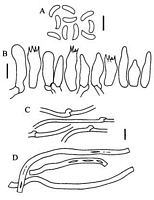|
 Antrodia novae-zelandiae Antrodia novae-zelandiae
BiostatusPresent in region - Indigenous. Endemic
Images (click to enlarge)
Caption: Fig. 1 Antrodia novaezelandiae<\EM>. A, basidiospores; B, basidia and cystidioles; C,
generative hyphae; D, skeletal hyphae. PDD 37440, holotype. Scale bars = 5 µm. |
Article: Buchanan, P.K.; Ryvarden, L. (2000). New Zealand polypore fungi: six new species and a redetermination. New Zealand Journal of Botany 38(2): 251-263 (http://www.rsnz.org/publish/abstracts.php).
Description: Basidiocarps annual, resupinate, effused, easily broken when dry, up to 4 mm thick,
separable, lacking sterile margin; pore surface light brown becoming straw-coloured
(79.1.y Br - 76.1.y Br), pores angular 3-4 per mm, dissepiments entire, tubes concolorous
with the pore surface, subiculum. very thin, white. Hyphal system dimitic; generative
hyphae with clamps, thin-walled, hyaline, 2-3.5 µm diam.; skeletal hyphae hyaline, thick-walled to
semisolid, sinuous to straight, 2-4 µm diam. Globules of a resinous substance
are prominent amongst hyphae in microscopic preparations. Cystidia absent. Cystidioles
fusoid, non-projecting, scattered among basidia, 9-14 x 3-11 µm. Basidia clavate, 4-sterigmate,
with a basal clamp, 10-15 x 3.5-5 µm. Basidiospores allantoid, hyaline,
smooth, IKI-, 4-5 x 1.2-1.5 µm. Causes a brown cubical wood rot.
Habitat: SUBSTRATA: On unknown dead hardwood tree.
Distribution: New Zealand, known only from the type location.
Notes: ETYMOLOGY: novaezelandiae, after the country of origin.
NOTES: A. novaezelandiae resembles A. sinuosa (Fr.) P.Karst. of the northern temperate
zone, but is distinguished by the more regular and smaller, angular pores, an evenly
straw-coloured pore surface, presence of a resinous substance throughout the basidiocarp,
and somewhat smaller basidiospores (cf. A. sinuosa 4-6 x 1-2 µm, Ryvarden &
Gilbertson 1993). A. sinuosa occurs almost exclusively on dry coniferous wood and is not
irnowr from the Southern Hemisphere to our knowledge. A. xantha (Fr.: Fr.) Ryvarden,
another species that occurs in New Zealand and elsewhere with E resupinate habit and
allantoid spores, differs from A. novaezelandiae in having smaller pores (5-7 per mm), a
yellow colour when fresh, lack of resinous material, and distinctly crumbly texture when
dry.
|